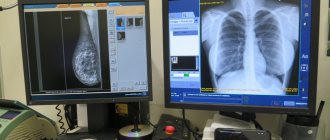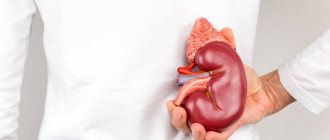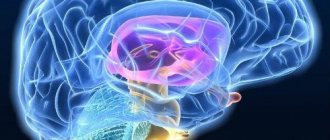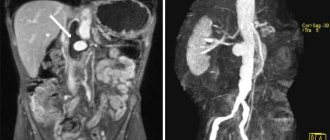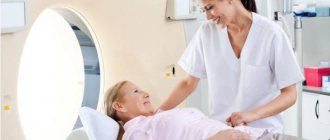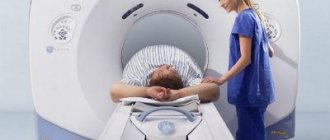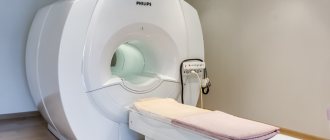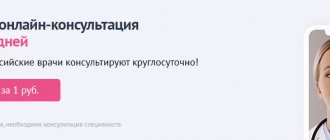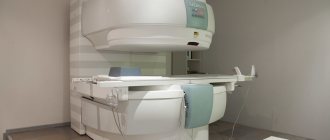Computed tomography of the kidneys is a highly informative, safe diagnosis of the new generation. Doctors now have access to accurate data that allows them to recognize cancer, cysts, and other neoplasms, track the functioning of organs, and create a picture of metastases. Thanks to the sections, you can see any area previously hidden from the eyes of specialists. The method is based on X-ray visualization with powerful sensors that detect any changes. The viewing angle is 360 degrees. The survey data is transferred to a computer, where a complete picture is formed and decrypted. When looking for a place to do such an examination, give preference to a reputable medical institution - the Central Clinical Hospital of the Russian Academy of Sciences in Moscow.
What is examined with a kidney CT scan?
The following specialists can refer you for a CT scan of the kidneys: a urologist, nephrologist, oncologist, therapist or surgeon. The study is prescribed for the purpose of:
- Visualization of the kidneys and urinary tract, other adjacent systems.
- Determining the correct position of the kidneys and bladder.
- Diagnosis of changes in development, abnormal shape, placement of kidneys in the abdominal cavity, fusion, incorrect number of organs.
- Research for kidney stones and associated pathologies.
- Diagnosis of oncology, benign formations, tumors of the retroperitoneal space.
- Adrenal gland research.
CT or MRI of the kidneys - which is better?
MRI and CT create layer-by-layer images, from which the doctor can accurately diagnose and prescribe treatment. But the principles of operation of the equipment, indications and contraindications for these types of research differ.
Information content
A kidney CT scan uses X-rays, while a magnetic resonance imaging scan uses a magnetic field. Both methods will show:
- size, structure and position of organs;
- neoplasms;
- condition of blood vessels.
Computed tomography of the kidneys is more informative in case of urolithiasis, since MRI does not clearly see calcium-containing structures. Using a CT scan of the kidneys, the specialist evaluates the diameter and location of dense formations in the renal pelvis and ureters, determines the tactics for non-invasive crushing or surgical removal of stones.
Magnetic resonance provides more information about the type and origin of cysts, while CT of the kidneys only visualizes such objects without identifying the probable causes of their development.
Safety of MRI and CT scans of the kidneys
Due to the use of X-rays, CT (computed tomography) of the kidneys has certain limitations:
- the examination is contraindicated for pregnant women and young children;
- MSCT or conventional tomography of the kidneys can be done no more often than once every six months;
- It is recommended to examine one area in one session.
In the absence of contraindications, magnetic resonance examination is harmless to the patient:
- the procedure can be repeated more often;
- unlike MSCT and kidney CT, MRI is allowed for expectant mothers and children of any age;
- if necessary, several areas or even the entire human body are studied during one visit.
Indications for use
A CT scan of the kidneys is performed in the following cases:
- The presence of tumors and other formations of unknown origin in the pelvic area.
- Kidney stones or other obstructions.
- Polycystic disease, abscesses, congenital anomalies.
- Other diseases affecting the kidneys and related organs.
- Impossibility of conducting other research methods.
Cost in Moscow
The price for a CT scan of a child’s kidneys in Moscow is determined by several factors, including the procedure for conducting the study (planned, emergency), the form of ownership of the clinic (state, private), and the need to administer a contrast agent. Urgent procedures, as a rule, are more expensive than planned ones. Scanning at government agencies usually costs less than scanning at private facilities. When using a contrast agent, the cost of the procedure almost doubles, while the price of a CT scan of the kidneys for a child in Moscow may fluctuate, since the drug is calculated taking into account the patient’s body weight. In addition, the cost of a kidney CT scan for a child in Moscow is influenced by the administration of medications during sedation and the availability of additional services (observation after anesthesia, recording results on electronic media, etc.).
Contraindications
Due to the use of modern equipment and professionalism of specialists, risks and contraindications are minimal. If a CT scan of the kidneys with contrast is performed, there are restrictions for some patients due to possible allergies to components of the injected substances. Patients with allergies to shellfish, iodine or medications are at risk. There is also a risk for:
- Nursing and pregnant women.
- Diabetic patients.
- People who have increased creatine levels.
- Patients with theriotoxicosis.
- Patients with impaired blood clotting.
- With a high degree of obesity.
CT diagnostics of kidneys in Moscow: where to go
If you are interested in CT diagnostics of the kidneys in Moscow, seek advice from one of the medical centers on Arbat. Doctors at Stolitsa are highly qualified specialists, authors of many scientific studies with academic degrees. The Medical Center has state-of-the-art equipment necessary for CT diagnostics. In “Stolitsa” on Arbat you will find a cozy atmosphere, polite staff, inexpensive and high-quality service. Low prices and positive reviews from patients at Stolitsa clinics are a guarantee of our work. Please note that at the Stolitsa clinic, CT diagnostics of the kidneys is cheaper at night. You can find out more details and make an appointment by calling the numbers listed on our contacts page.
Preparation
Preparation for the study will be the key to successful diagnosis and further treatment. CT without contrast does not require special preparation, only following simple recommendations. It is necessary to pay special attention to this stage and follow all instructions on how to prepare:
- It is important to inform your doctor about the medications you are taking and possible allergies to medications and other substances. It is especially important when performing a CT scan of the kidneys with contrast.
- Allergy to contrast agents should be ruled out in advance.
- Correcting your diet will relieve the digestive system and reduce the likelihood of bloating.
- It is necessary to conduct a blood test and other preliminary studies if the clinical picture requires it.
- The patient must change into appropriate clothing, remove all metal objects, jewelry, dentures, etc.
Risks of CT scan of the kidneys
The patient can ask the attending physician about the amount of radiation during the test.
The patient is advised to keep a record of all x-ray examinations performed previously for other reasons. The risks of harmful effects from radiation may be related to the number of x-ray procedures, since the damaging effects of radiation are increased with repeated examinations.
The patient should inform the radiologist if:
- The patient is or is suspected of being pregnant. Radiation exposure during pregnancy can cause congenital anomalies in the fetus.
- The patient is allergic or hypersensitive to medications, contrast agents, local anesthetics, iodine, or latex
- The patient has kidney failure or other kidney disease. In some cases, the use of contrast can lead to the development of kidney failure.
- The patient is taking certain medications for diabetes (for example, metformin), since in combination with contrast, the risk of developing a dangerous change in blood pH (metabolic acidosis) sharply increases.
- The patient may have other conditions for which a CT scan would not be advisable.
Certain circumstances may reduce the accuracy of a CT scan. These include:
- Metal objects, such as surgical forceps in the abdomen
- Barium in the intestine after a recent study with this contrast agent
- Recent procedures using contrast agents or other substances
How is a kidney CT performed?
The procedure is performed on an outpatient basis. The radiologist will tell you how the study is carried out, clarify how to behave, and what position to be in. If a contrast dye test is being performed on the kidneys, a catheter will be inserted into the elbow or groin area. Comfortable fixation of the patient is carried out using belts and pillows, if necessary.
The patient is placed on a movable table into the scanner, which will rotate while taking readings. The process is controlled using a remote control; the doctor can give instructions to the patient, which must be followed. After using a contrast agent, it is necessary to increase your water intake so that the substance leaves the body faster.
Procedure for performing CT angiography
An intravenous catheter will be placed in the patient before the procedure begins to administer a contrast agent. The volume of contrast and the speed of its introduction into the vein depend on the age, weight and constitution of the patient.
Next, the patient lies down on the table, which will move smoothly after turning on the tomograph. The patient must remain calm and not get up. As the contrast agent passes through the veins, you may feel hot and slightly dizzy. Mild symptoms are normal. If you suddenly feel unwell, tell your doctor. He watches you from the next office, hears you and can talk to you on speakerphone all the time.
The entire scan takes about 2 minutes. After this, the patient can stand up, the catheter is removed from the vein. The results and doctor’s report are issued after processing the images.
Kidney CT scan with contrast
A CT scan can be performed with or without a contrast agent. The point of introducing this drug is that, due to its properties, it is opaque to x-rays. This makes it possible to study the vessels of the kidneys and make an accurate diagnosis in the presence of tumors, cysts and other changes. The boundaries of organs can only be distinguished during contrast-enhanced studies. That is, you can consider the density and structure of the object of study.
Computed tomography of the kidneys with and without contrast
After the procedure
If contrast was used during the study, the patient may experience adverse reactions such as itching, swelling, and rash.
You may also experience symptoms such as redness and pain in the area where the contrast was administered. In such cases, you must inform your doctor.
If there are no reactions, the patient can return to their normal lifestyle.
Typically, CT scans of the kidneys, especially with contrast, provide sufficient information about the morphology of these organs. However, if differential diagnosis is necessary, other diagnostic methods may be recommended.
Cost of tomography
| Name of service | Service price |
| Computed tomography (CT) | |
| CT scan of the chest | 12300.00 RUR |
| CT scan of the chest (with contrast enhancement) | 13300.00 RUR |
| CT scan of the brain | 7100.00 RUR |
| CT scan of the brain (contrast-enhanced) | 12100.00 RUR |
| CT scan of each jaw | 7100.00 RUR |
| CT orbits | 7200.00 RUR |
| CT of the orbits (contrast-enhanced) | 12200.00 RUR |
| CT scan of the paranasal sinuses | 7100.00 RUR |
| CT scan of the temporal bone | 7100.00 RUR |
| CT scan of the pharynx, larynx | 7100.00 RUR |
| CT scan of the pharynx, larynx (with contrast enhancement) | 12100.00 RUR |
| CT scan of the thyroid gland | RUB 6500.00 |
| CT scan of the thyroid gland (with contrast enhancement) | 11500.00 RUR |
| CT neck | 7500.00 RUR |
| CT scan of the neck (with contrast enhancement) | 12500.00 RUR |
| CT scan of the clavicle, scapula, sternum | RUB 6500.00 |
| CT scan of the cervical spine | 7100.00 RUR |
| CT scan of the thoracic spine | 7100.00 RUR |
| CT scan of the lumbosacral spine | 8100.00 RUR |
| CT coccyx | 6800.00 RUR |
| CT scan of the pelvis | 7100.00 RUR |
| CT scan of long bones (femur, tibia and fibula, humerus, radius, ulna) (1 bone) | 6100.00 RUR |
| CT scan of the shoulder joint (1 joint) | 7100.00 RUR |
| CT scan of the wrist joint (1 joint) | 7100.00 RUR |
| CT scan of the knee joint (1 joint) | 7100.00 RUR |
| CT scan of the ankle (1 joint) | 7100.00 RUR |
| CT scan of hands/feet (1 hand/foot) | 7100.00 RUR |
| CT scan of the hip joint (1 joint) | 7100.00 RUR |
| CT scan of the elbow joint (1 joint) | 7100.00 RUR |
| CT scan of sacroileal joints (1 joint) | 7100.00 RUR |
| CT scan of the abdominal cavity and retroperitoneum | 9200.00 RUR |
| CT scan of the abdominal cavity and retroperitoneal space (with contrast enhancement) | 14200.00 RUR |
| CT scan of the liver, pancreas, spleen | 7400.00 RUR |
| CT scan of the liver, pancreas, spleen (with contrast enhancement) | 12400.00 RUR |
| CT scan of kidneys, adrenal glands | 7400.00 RUR |
| CT scan of the kidneys, adrenal glands (with contrast enhancement) | 12400.00 RUR |
| CT scan of the pelvic organs | 7400.00 RUR |
| CT scan of the pelvic organs (with contrast enhancement) | 12400.00 RUR |
| CT scan of the urinary system (kidneys, ureters, bladder) | 9200.00 RUR |
| CT scan of the urinary system (kidneys, ureters, bladder) (with contrast enhancement) | 14200.00 RUR |
| CT angiography of the aorta (CT-panortography) | 9200.00 RUR |
| CT angiography of the pulmonary artery + thoracic aorta (with contrast enhancement) | 14200.00 RUR |
| CT angiography of the arteries of the upper extremities or lower extremities (with contrast enhancement) | 12400.00 RUR |
| CT scan of head vessels (with contrast enhancement) | 11200.00 RUR |
| CT scan of neck vessels (brachiocephalic) (with contrast enhancement) | 11200.00 RUR |
| CT scan of head and neck vessels (with contrast enhancement) | 17000.00 RUR |
| CT scan of the thoracic/abdominal aorta (with contrast enhancement) | 14200.00 RUR |
| CT scan of the stomach (reg. size) | 12100.00 RUR |
| CT scan of the stomach (double contrast reg, oz i/v) | 14200.00 RUR |
| CT scan of the intestines (reg.oz) | 12100.00 RUR |
| CT scan of the intestine (double contrast reg, oz i/v) | 14200.00 RUR |
| CT scan of the skull bones.. | 9400.00 RUR |
| Producing a VD image on medical X-ray film (1 image) | 200.00 RUR |
